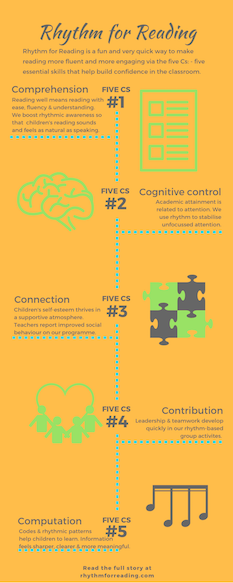The Rhythm for Reading blog
Rhythm and Computation 5/5
5 November 2018I had no idea that I would be writing a post on computation whilst working in Silicon Valley – I am amazed by the coincidences that life delivers. It seems that music and technology go together here and I look forward to exploring some of the ideas behind the Rhythm for Reading programme in relation to the principles of computational thinking.
Historically, the word compute derives from Latin roots: com (together) and putare (to settle an account). In the French language of the 17th century, the verb ‘computer’ meant to reckon or to calculate the amount. As we know only too well from the reporting of negotiations between the UK and EU, it is important to attend to the broad principles as well as the details. From the perspective of computer science, a systematic approach is used to align the broad principles and the fine details by following a process involving four cornerstones of computational thinking: decomposition, pattern matching, abstraction and algorithms.

Decomposition: In general, music is associated with ‘composition’ rather than decomposition. However, playing any piece of music involves decomposition. Before performing, musicians are faced with a problem: how should the music sound and feel? They answer this question by considering musical elements such as, form and tempo (overall layout and speed), harmonic structure (organisation of key changes in relation to the form), rhythmic and melodic features (beats, riffs, tunes, patterns and repetitions), as well as the texture - the distribution of the sounds in relation to each other. Each musical style has a fairly typical blueprint consisting of certain types of form, harmonies, textures, rhythms and melodies which musicians constantly refine with experience.
Pattern recognition: For many people, the appeal of music lies in its attention grabbing patterns, the hypnotic qualities of repeating beats and the deeply satisfying musical feel of certain riffs and grooves. This is not surprising because like other mammal species, our early development took place surrounded by the rhythm of our mother’s heartbeat, respiration and digestion patterns. New born infants can detect changes in rhythmic patterns of language and music with remarkable sensitivity. It seems that pattern recognition begins very early on in our development and continues throughout life.
In computational thinking, the extraction of general information from a recognised pattern (e.g. all dogs have four legs) involves looking for similarities and disregarding everything else. Well, when we listen to music and extract the beat from the complete musical sound – (just before we begin nodding or tapping along with it), we have extracted the constantly recurring ‘generalised’ information and brought this to the front of our awareness. In this way, the beat becomes useful as an organisational device because we naturally perceive the other more varied and changeable sounds in relation to it.
Abstraction: The process of abstraction, knowing what to retain and what to ignore as part of pattern recognition is an acquired discipline that becomes second nature with practice. For example, finding the beat and focusing on it (perhaps whist taking exercise) is a powerful form of orientation in musical sound that most people naturally adopt. The process of recognising rhythmic patterns via the extraction and abstraction of the beat often happens spontaneously and extremely quickly – in a matter of a few seconds, depending rather on the quality of the musical sounds.
Algorithms: An algorithm is a sequence of steps required to build a model of a solution to a problem, such as a series of instructions or rules to make a cup of tea. To programme a robot to make a cup of tea would be complex because the single instruction ‘pour’ for example would need to be broken down into all the tiny action pieces (involving angles, weight, resistance, timing etc). Returning to music, having abstracted the beat from musical sounds, it is possible to rebuild a sense of the organisation of the music in relation to the beat. For example, there may be recurring catchy tunes or rhythmic patterns that make the music instantly recognisable. The beat is the organisational principle in our brain’s perception of musical sounds. Similarly, the beat is also the organisational principle of musical sounds as represented in musical notation. The representation of music in music notation involves a framework called a musical staff, consisting of five horizontal lines. The system of notation is rule-based and the information it contains is extremely precise. However, like an algorithm, only the necessary details are included; all other musical information is inferred by (stylistically aware) musicians.
In Rhythm for Reading sessions, there is a strong emphasis on beats, riffs, patterns and repetitions, as well as on an awareness of the form and structure of a piece of music. After a couple of sessions, even very young children spontaneously apply the principles of decomposition and pattern recognition. Their innate awareness of sound prompts them to extract and abstract the beat and to feel the organisation of melodic and rhythmic patterns around the beat. They love to discover the patterns in musical notation and can use these to explain the overall organisation of simple pieces of music.
It’s been fun to play a little with the idea of explaining musical processes in terms of computational thinking – there is certainly plenty of common ground. However, there is also an important difference. While computational thinking occurs in a sequence, which is later integrated by a computer, the musical equivalents of decomposition, pattern recognition, abstraction and algorithms are integrated by the human brain’s capacity to read musical notation, to elaborate the notation and produce musical sounds in time with others. Not only do we integrate all of these processes naturally, we find it highly rewarding to do this <in sync>.
